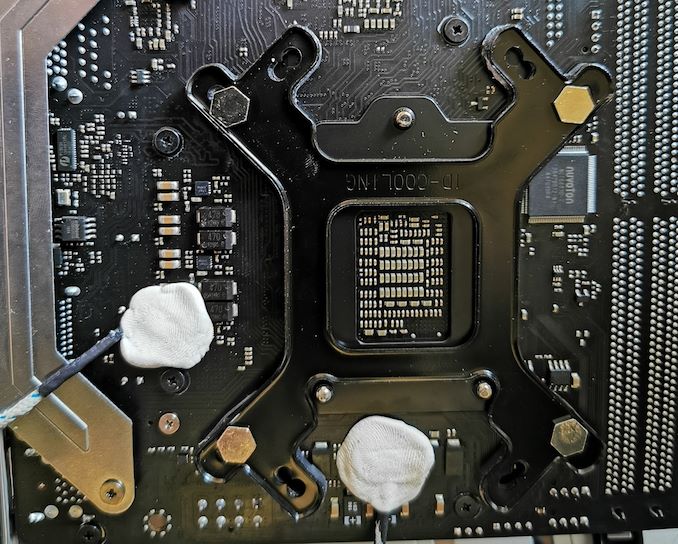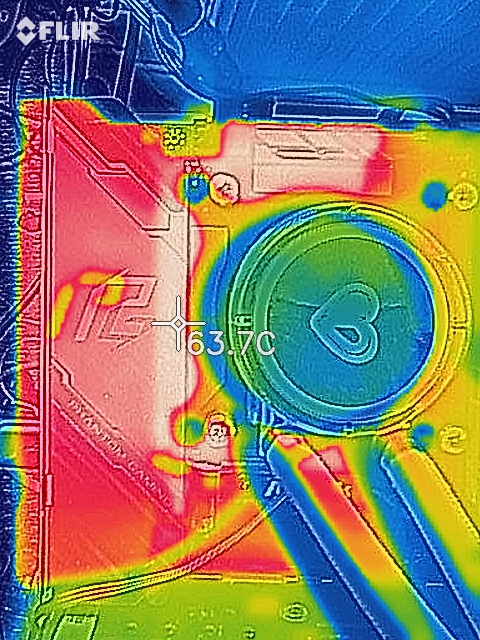AMD + ITX + TB3? It's the ASRock X570 Phantom Gaming-ITX/TB3 Motherboard Review
by Gavin Bonshor on October 9, 2019 12:00 PM ESTPower Delivery Thermal Analysis
One of the most requested elements of our motherboard reviews revolves around the power delivery and its componentry. Aside from the quality of the components and its capability for overclocking to push out higher clock speeds, which in turn improves performance, it is the thermal capability of the cooling solutions implemented by manufacturers that can have the biggest effect. While most solutions are almost always fine for users running processors at default settings, those looking to squeeze out extra performance from the CPU via overclocking put extra pressure on the power delivery. This is why more premium models often include heatsinks on its models with better cooling designs, heftier chunks of metal, and in some cases, even with water blocks such as the ASUS ROG Crosshair VIII Formula.

Two K-Type Thermal Probes attached to the rear of the power delivery on the ASRock X570 Phantom Gaming-ITX/TB3
Testing Methodology
Out method of testing out if the power delivery and its heatsink are effective at dissipating heat, is by running an intensely heavy CPU workload for a prolonged method of time. We apply an overclock which is deemed safe and at the maximum that the silicon on our AMD Ryzen 7 3700X processor allows. We then run the Prime95 with AVX2 enabled under a torture test for an hour at the maximum stable overclock we can which puts insane pressure on the processor. We collect our data via three different methods which include the following:
- Taking a thermal image from a birds-eye view after an hour with a Flir Pro thermal imaging camera
- Securing two probes on to the rear of the PCB, right underneath CPU VCore section of the power delivery for better parity in case a probe reports a faulty reading
- Taking a reading of the VRM temperature from the sensor reading within the HWInfo monitoring application
The reason for using three different methods is that some sensors can read inaccurate temperatures, which can give very erratic results for users looking to gauge whether an overclock is too much pressure for the power delivery handle. With using a probe on the rear, it can also show the efficiency of the power stages and heatsinks as a wide margin between the probe and sensor temperature can show that the heatsink is dissipating heat and that the design is working, or that the internal sensor is massively wrong. To ensure our probe was accurate before testing, I binned 10 and selected the most accurate (within 1c of the actual temperature) for better parity in our testing.
For thermal image, we use a Flir One camera as it gives a good indication of where the heat is generated around the socket area, as some designs use different configurations and an evenly spread power delivery with good components will usually generate less heat. Manufacturers who use inefficient heatsinks and cheap out on power delivery components should run hotter than those who have invested. Of course, a $700 flagship motherboard is likely to outperform a cheaper $100 model under the same testing conditions, but it is still worth testing to see which vendors are doing things correctly.
Thermal Analysis Results

We measured 63.7°C on the hottest part of the board during our testing
The ASRock X570 Phantom Gaming-ITX/TB3 uses a 10-phase power delivery which is running in a 4+2 configuration. The CPU section consists of eight ISL99227 60 A power stages which are paired up with four ISL6617A doublers, while the SoC section consists of two ISL99227 60 A power stages. Controlling the power delivery is a Renesas ISL69147 PWM controller. The cooling solution on the ASRock X570 Phantom Gaming-ITX/TB3 consists of two individual heatsinks; one aluminium heatsink which is a combined piece with the rear panel cover, and a separate SoC section which also cools two of the power stages of the CPU section. It's actually a really nice design as the aluminium rear panel cover is quite beefy and will benefit from cases with good passive airflow. -
Looking at our power delivery thermal testing results, the ASRock X570 Phantom Gaming-ITX/TB3 performs pretty well considering it's using a 10-phase design on such a small mini-ITX sized PCB. There are increased thermal properties to consider when running a high-powered mini-ITX system as condensed componentry tends to generate a little bit more heat than a sparser ATX PCB would. With 1.475 V set on the CPU VCore and the CPU Core Frequency set to 4.1 GHz, our temperatures maxed out at 64°C on ASRock's integrated VRM temperature sensor. Our probe on the rear measured 61°C, with our thermal imaging shot measuring 63.7°C on the hottest part of the power delivery. This is a good result for ASRock and although it doesn't quite have the cooling capabilities as some of the flagship models we have tested so far, for a $240 model with so much power and features on a mini-ITX sized model, temperatures in our testing we're absolutely fine. A processor such as the Ryzen 9 3950X with 16-cores is likely to stress the power delivery more than our Ryzen 7 3700X, but it's not likely to push the VRM temperatures into dangerous waters.











64 Comments
View All Comments
TheinsanegamerN - Wednesday, October 9, 2019 - link
Except there is no expansion do do so...oops.This is mini ITX. This stuff NEEDS to be on the board. You can tjust add it, there is nowhere to do so!
Death666Angel - Thursday, October 10, 2019 - link
May I introduce you to the concept of USB hubs?Valantar - Wednesday, October 9, 2019 - link
Leaving the x4 m.2 PCIe link off the CPU on the table is bordering on criminal. Sure, the board is packed nonetheless, but when every single competing board has two m.2 slots, this is a no-go. Sure, TB3 would be nice, but to be realistic the only thing it would be used for would be TB3 networking when needing to do quick file transfers to a laptop. Not worth the loss of a second m.2 slot by a long shot. And sure, I could get a TB3 SSD case - and drive up the price of that second drive by 2-3x. No thank you. I'll likely go for the Gigabyte or the Strix.Valantar - Wednesday, October 9, 2019 - link
Worth adding: a legitimate use case for this would be connecting the upcoming Apple monitor. Not many SFF desktop PCs capable of that. But will that even work with non-Apple hardware?Calamarian - Thursday, April 16, 2020 - link
As far as I know no WinPC thunderbolt 3 connection would work as apple "over-clocks" it's TB3 connections to run the Apple display... :(TheinsanegamerN - Wednesday, October 9, 2019 - link
Could it be lack of trace room? Socket AM4 is bigger, leaving less space to run traces, and you already have a LOT going through a small space.DigitalFreak - Thursday, October 10, 2019 - link
While I agree with you, I'm guessing they did it because using the x4 link on the CPU for NVMe wouldn't allow the M.2 slot to support M.2 SATA drives as well. That said, they should have run the Thunderbolt controller off that x4 link if it wasn't being used.TheinsanegamerN - Wednesday, October 9, 2019 - link
Why dont they put this level of effort into micro ATX boards?DanNeely - Wednesday, October 9, 2019 - link
Because sales have imploded. The people who care about size have left for miniITX as the relevance of SLI/XFire has vanished and the price/performance penalty for the smaller size has withered away. The part of the market that doesn't care is sticking with full ATX because why not,their case holds a full size board, they might need one of the extra connectors someday, and besides the more spread out layout makes getting all the connectors in easier.
Pushing higher PCIe standards more than a few cm is going to get increasingly expensive; which is why AMD hasn't offered a 550 chipset with PCIe4 yet. Cost reasons might push mainstream PCIe4 boards out of the full ATX range. PCIe5 is much worse; to the extent that it might not become a consumer standard at all; it's looking like just reaching from the CPU to the top PCIe slot or chipset will either need expensive redriver chips or PCBs that cost a few hundred dollars for a full sized board. Assuming it happens at all, I suspect that will put a lot of price pressure towards a revival for micro ATX.
jeremyshaw - Wednesday, October 9, 2019 - link
I feel they'll just have the top slot be PCIe 4/5, then all of the other slots at PCIe 3 or even 2. Depending on chipset placement, it may not even be viable for the chipset to have PCIe5.